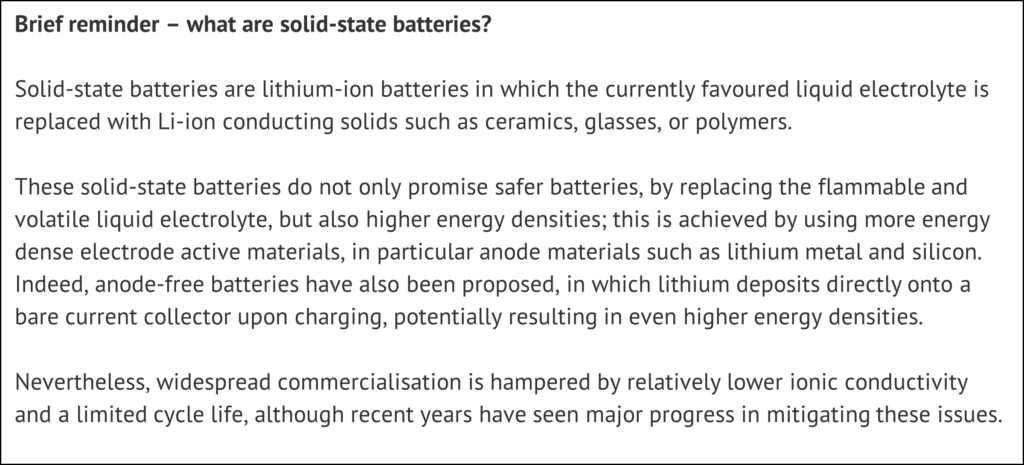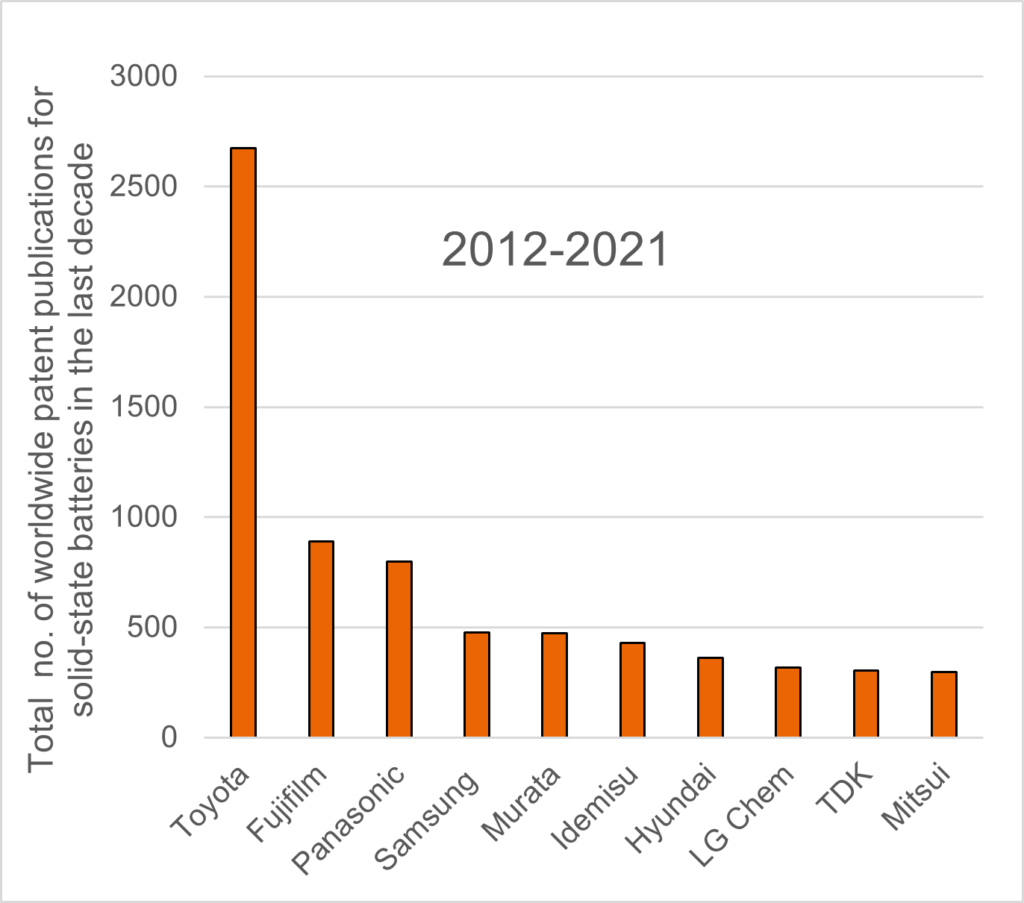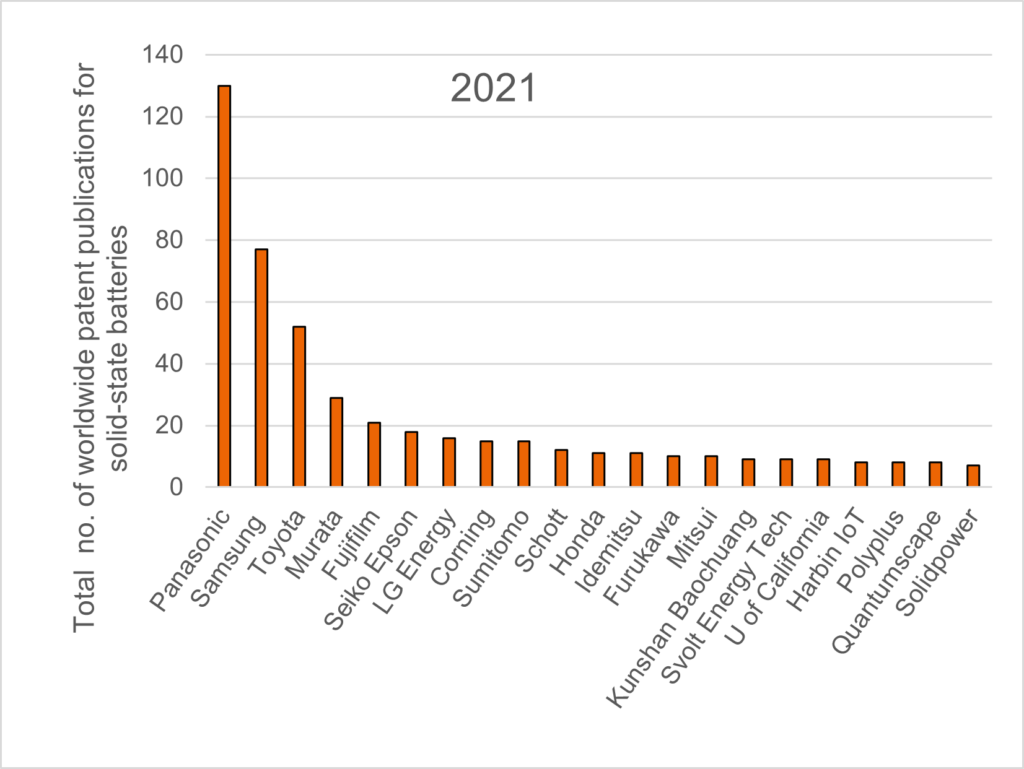27/06/2022
We last took a look at the patent landscape for solid-state batteries over three years ago, and since then, interest in the technology has only grown. Indeed, the massive rise in demand for electric vehicles has only served to further the future importance of solid-state batteries to automotive OEMs and battery manufacturers.
This is supported not only by the number of patent applications being filed in this area (more on those below), but also by the large number of news stories relating to solid-state batteries, and their rapid progress to commercialization, in the last few months. Only by way of example, Solid Power (a solid-state battery developer) is due to start delivering solid-state batteries for testing to BMW and Ford by the end of the year, Volkswagen has invested heavily in Quantumscape (another solid-state battery company), and Toyota has announced that it wants to put solid-state batteries in commercial hybrid cars by 2025.

So what can the patent landscape tell us about the research and development of solid-state batteries?
As we said three years ago, research and development of solid-state batteries is clearly accelerating, and the trend has continued. In 2009, the number of patent publications related to solid-state batteries worldwide (CPC classification code H01M 10/0562) was just 337, and had risen to over 1300 by 2016. Since then, the increase in the number of patent publications in this field has only accelerated, with about 4000 patent applications published in 2021 alone (see Figure 1). This equates to a 10-fold increase in the 12 years between 2009 and 2021, and about a 3-fold increase in the 5 years since 2016.

We note that although this CPC class includes any kind of secondary battery using an inorganic solid electrolyte, almost all of the patent applications published in 2021 mention lithium-ion.
So, has anything changed in the last few years?
Although one needs to be mindful when drawing conclusions about research and development activity from patent publications, in part because of the 18 month gap between first filing of a patent application and its publication, one trend has been unambiguous: the rise of battery manufacturers relative to automotive OEMs, which had for years dominated patent publications in the field of solid-state batteries.

In particular, Toyota still has, by far, the greatest number of patent publications published relating to solid-state batteries when looking at the last decade (2012-2021, see Figure 2). However, in 2021, both Panasonic (130) and Samsung (77) had more patent applications published than Toyota (52), as shown in Figure 3. This appears to demonstrate an increasing investment of battery manufacturers into solid-state battery research – and is perhaps also a reflection of the fact that many automotive OEMs have been looking to diversify where they get the batteries for their EVs and hybrid vehicles from, and to perhaps even manufacture batteries themselves.

It is also interesting to note that the largest patent filers in this field are rounded out by relatively smaller and/or more recent, research-intensive, companies such as Svolt (9), Polyplus (8), Quantumscape (8), and Solidpower (7), some of which have active cooperation agreements with multinational battery manufacturers or automotive OEMs.
Asia remains the dominant region in solid-state battery research
One fact that has not changed, however, is the dominance of Asian, and in particular Japanese and Korean, companies in solid-state battery research. Eight of the ten companies with the most patent applications published in 2021 are from Asia.
Nevertheless, governments across Europe have been investing heavily in making their country a battery powerhouse (excuse the pun), including in the area that is seen by many as the future of lithium-ion batteries: solid-state batteries. For example, in the UK, the government has been investing heavily into battery research, including solid-state batteries, via the Faraday Institution (£246m research funding). And Germany is investing in a cluster researching materials for solid-state batteries.
Indeed, none of this even considers that European (and American) automotive OEMs have been investing significantly into solid-state battery research, and start-ups with relevant knowhow and intellectual property, for years.
So what conclusions can we draw from all of this?
It still seems clear that Asian companies such as Panasonic, Samsung, and Toyota are in the driving seat when it comes to solid-state batteries. However, European and American automotive OEMs as well as research-intensive European, American, and Chinese start-ups are catching up. And with solid-state batteries only just getting to the stage where large-scale commercialisation is realistic in, say, the next five years, it remains to be seen which companies will be able to protect the most important inventions.
However, given the extensive supply chain, and manufacturing technologies, required for the production of solid-state batteries, most inventions are likely worth protection.
Considering the added complexity of solid-state battery manufacture, this is particularly true for manufacturing technologies and methods. For example, ensuring a good electrode-electrolyte interface is challenging. Protecting the core inventions required for successful manufacture of solid-state batteries will be critical in protecting a company’s research – and future value.
If you would like any advice on how, and what, developments to protect in this area or any other related area such as battery technology or materials science, please get in touch.
This article is for general information only. Its content is not a statement of the law on any subject and does not constitute advice. Please contact Reddie & Grose LLP for advice before taking any action in reliance on it.


